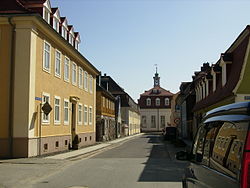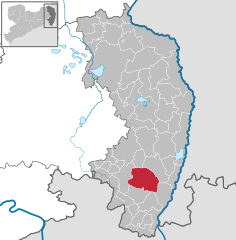It is located in the historic Upper Lusatia region, on the road Bundesstraße 178, and on the Zittau–Löbau railway line. Herrnhut is about 10 km (6.2 mi) south-east of Löbau, 15 km (9.3 mi) north-west of Zittau, and 25 km (16 mi) south-west of the district capital Görlitz.
The municipality borders on, among other municipalities, Oderwitz.
Subdivisions
Herrnhut is also the name of the largest town in the municipality. Since 1 January 2013, when Berthelsdorf was incorporated, the municipal area contains 11 subdivisions:
| This section does not cite any sources. (December 2021) |
Herrnhut proper was founded in the early 18th century by German-speaking members of the Unity of the Brethren, religious refugees from Margraviate of Moravia. The Unity of the Brethren arose after the reformer Jan Hus had been burnt at the stake during the Council of Constance in 1415. In the 18th century, they had to face the stern Counter-Reformation measures enacted in the Lands of the Bohemian Crown by the Habsburg rulers. From 1722 refugees came to Upper Lusatia, held by the Electors of Saxony since the Peace of Prague (1635). After meeting with their leader Christian David, a Moravian missionary, the German nobleman Count Nikolaus Ludwig von Zinzendorf (1700–1760) invited them to settle on his extended Berthelsdorf estates.
Shortly afterward, David built the first home in what was to become Herrnhut. Herrn Hut means the Lord's watchful care or the Lord's protection. Zinzendorf himself had a new residence erected here in 1725–1727). From Herrnhut the community spread to Rixdorf near Berlin, the former Marienborn monastery near Büdingen, to Herrnhaag, to Norden, to Pawlowitzke (1771–1772). Numerous daughter churches arose all over the world. The first organized Protestant missionary movement began from Herrnhut in 1732, when 2 Bohemian Brethren went to the Danish West Indies, and then others went also to Greenland. The first North American mission work began in Savannah, Georgia in 1735. In 1738, the missionary station of Genadendal was founded in South Africa. Christiansfeld in Denmark followed in 1771.
Herrnhut holds a prominent place in the history of Protestantism, as well as the broader history of Christianity. Zinzendorf's community influenced John Wesley in creating Methodism and it contributed to the rise of Evangelicalism, a broad interdenominational movement of more than 300 million people all over the globe.
| Year | 1834 | 1871 | 1890 | 1910 | 1925 | 1939 | 1946 | 1950 | 1964 | 1990 | 2000 | 2010 |
| Population | 899 | 1092 | 1139 | 1364 | 1664 | 1627 | 2024 | 2025 | 1808 | 1754 | 2842 | 4963 |
According to the Saxon state congress in 1777, Herrnhut contained 76 homes.
In the mid-19th century the population rose above 1,000, and after World War II it reached more than 2,000. Since the 1950s there has been a decline in population, which was compensated for by the incorporation of neighboring municipalities.[3]
Map of Oberreit with Herrnhut, around 1845
Map of Oberreit with Herrnhut and Strahwalde, around 1845
Map of Oberreit with Herrnhut and Ruppersdorf, around 1845
The Herrnhut coat of arms is blue and white, showing the tower of the Altan (the lookout tower) atop the Hutberg hill above the city. The name of Hutberg hill ("Hill of Watching") suggested the name of the Moravian settlement founded by these exiles on the Zinzendorf estate in 1722. Herrn Hut means "the Lord's Watchful care".
Its economy is based on church administration, education, tourism and manufacturing, including a 25-pointed star that is often hung in windows and on porches during the Christmas season, which has been produced for over 150 years. It is called the Moravian star or Moravian Advent star (Herrnhuter Adventsstern or simply Herrnhuter Stern). From Herrnhut, the Moravian star decoration has spread across Europe and America.
Herrnhut, 1765
Church hall in Herrnhut
Vogtshof Herrnhut, seat of the
Moravian ChurchHerrnhut railway station [de] also functions as an art gallery
Nicolaus Zinzendorf monument in Herrnhut
Herrnhut "God's Acre", the graveyard of the Moravian Church since the 18th century
Wikivoyage has a travel guide for
Herrnhut.




